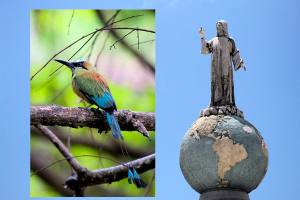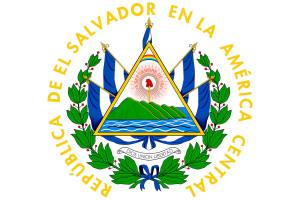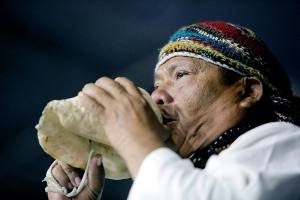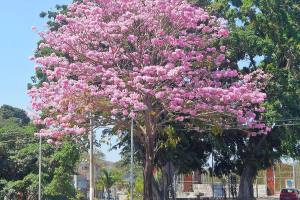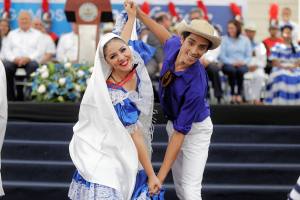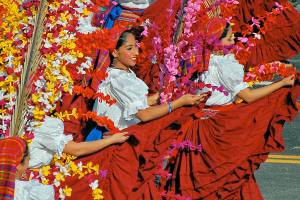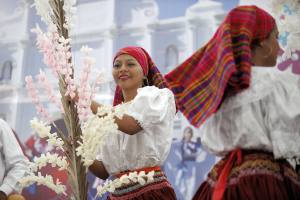It is quite likely that as children, we have heard stories that scared us, so today, we will know what those legends of El Salvador eventually prevented us from sleeping at night.
It is good to know that the word “legend” comes from the Latin Legenda, whose meaning is that which must hear; therefore, they are ancient oral narrations that tell actual or fictitious facts, decorated with elements of the folklore of each country.

LEGENDS OF EL SALVADOR - Traditions of El Salvador. Photo by Milton Parada. Flickr.
Generally, they are related to heroes of the homeland, ugly or imaginary creatures, and try to explain some facts of history, customs, and even the religiosity of the people or villages.
Over time they may lose integrity since the stories undergo transformations and generate different versions. However, they remain in force, transmitting between different generations as part of a country’s culture.
Let’s discover these fascinating Salvadoran folk tales, which add immense value to their identity besides being part of their traditions.
The most famous legends of El Salvador
Although there are many legends of El Salvador, here we will show the ten best-known found in almost every corner of the country.
1. The Siguabana
Legend has it that Sihuehuet or a beautiful woman becomes pregnant by the Sun God, who is the son of the god Tlaloc, and has a son named Cipitío but leaves him alone to be with his lover and goes out for a walk and have fun.
Fed the child only on ashes, and when Tlaloc found out, he cursed the mother, saying that her name would no longer be her but Siguanaba, which means a horrible woman.
She is condemned to wander along the highways and empty roads to frighten men who walk alone, are unfaithful, or are out late at night, forcing them to return home by showing them her horrible face.
2. The Cipitío
The most-known character among the legends of El Salvador is the son of Siguanaba. He is also cursed by the god Tlaloc, so he will never grow up and always look like a ten-year-old boy.
He is an amiable and mischievous figure who wanders and scampers around with his big belly and colossal hat, besides being able to teleport. He has deformed feet, so the peasants must pay close attention not to get lost on the road while following his footprints.
He enjoys eating ashes and being near rivers, where he plays tricks on the pretty girls who frequent these places, to whom he whistles, throws flowers, or laughs loudly.
It is also known as Cipit, which in the Nahuatl language means child, and by custom Salvadoran children are called “cipote.”
3. Amate Flower
Another of the attractive and enigmatic legends of El Salvador is the one referring to the goodness of the Flor de Amate, which gives us all its gifts in the form of “good luck.” The surprising thing about this tree is that it does not produce flowers, only twisted branches and lots of foliage.
Hence it is said that only the dumb can see its flowers at midnight, and you must take it very carefully with a white handkerchief; if you do it improperly, the blossom disappears since the Devil is its owner.
And only the dumb can do it, as they will never be able to say anything about this magical flower.
4. The Cadejo
In pre-Hispanic times, the Indians believed that dogs helped their masters to transcend to the afterlife at the moment of death.
This legend that is part of the legends of El Salvador undergoes some changes and is told to demonstrate the differences between good and evil, and thus was born El Cadejo.
The story tells that there are two dogs: the white cadejo, which represents good, and the black cadejo, which means evil.
These spirits have different objectives since the white cadejo protects believers and takes care of the souls of newborn children. In contrast, the black cadejo appears to those who wander at night or commit indecent or immoral acts.
5. The Globin
This exciting narrative of the traditional legends of El Salvador refers to an entity that falls in love only with beautiful girls in the villages, which bothers them in various ways. It plays some unpleasant jokes that do not intend to harm them.
He generally keeps himself discreet during the nights, keeping an eye on the damsels, but when they become aware of his presence, he begins to play his pranks. He always wears tight green suits and harlequin hats.
6. The Witch Wagon
One of the legends of El Salvador that instills more terror in the population, especially when the country’s highways and roads are alone at night, is the one referring to the terrible appearance of La Carreta Bruja, also known in some places as La Carreta Chillon.
Its name is due to the sound produced by the wooden wheels rolling on the pavement; it also says that this carriage rolls upside down and has no driver.
The sound in the silence of the night is so eerie that even animals are frightened. It is generally believed that the carriage is a spirit that collects the souls of those who wander along lonely roads to take them to the “other world.”
Some suggest that it carries within it the bones of the dead who have come out of their graves, calling lying or false people by their names and making macabre warnings.
7. The Righteous Judge of the Night
Since ancient times, this is a wandering ghost who rides on horseback, and in the place of his head, what comes out is a column of smoke.
He is usually well-dressed and carries a kind of noose or rope in his hands to punish those who dare to go out at night.
He dispenses justice in his particular way, asking and re-asking the same questions to the travelers he encounters on the roads of the interior.
If he considered a person to be honest and decent, he would reprimand him but allow him to continue on his way home; if, on the contrary, he considered him to be a bandit or a loafer, he would punish him by whipping him with a whip.
Then the Righteous Judge of the Night would continue his wanderings and ride away on his horse at full speed, causing the branches of the trees to move very agitatedly.
8. The Uncarnate One
Despite being a horror story spread throughout Latin America, level of La Descarnada is an essential part of the legends of El Salvador.
According to some people, this female figure appears walking along lonely roads waiting for a ride. She looks beautiful and very well dressed, and when an absent-minded driver stops to take her to the destination she indicates, she gets into the car.
Once inside the vehicle, she begins to seduce the car driver, but at the same time, a putrid stench permeates the air as the woman’s skin falls off, leaving only her skeleton.
Those saved from the evil clutches of this female specter, which is probably seeking revenge on unwary drivers, either die of a heart attack or are rendered mute for life. Others may leave with seriously damaged minds.
9. The Cuyancúa
Curiously, in Sonsonate and specifically in the municipality of Izalco. one of the legends of El Salvador that has accompanied us since the time of the Mayas is narrated since La Cuyancúa. In those times, she was considered the “messenger of the rains.”

This mythological being has a strange body shape since its upper part looks like a pig, the lower part is a snake, and its front legs look like human hands.
It is associated with rainstorms, and it is said that since it cannot walk, it crawls, causing solid movements in the earth, accompanied by intense shrieking.
On the other hand, some say that this strange creature can generate water and springs only by lying on dry land. After a while, it rises and has already created a source of pure water.
When tourists visit the Atecozol Aquatic Park, they can observe a stone sculpture of this fantastic animal.
10. The Black Knight
In Central American mythology, the Black Knight has been part of the legends of El Salvador since ancient times.
It also belongs to the collective imagination to know that this monster is nothing more and nothing less than the Devil himself.
When someone was in trouble, be it money or otherwise, they would invoke Satan, who appeared mounted on a fantastic black horse, elegantly dressed, with beautiful and shiny saddles, and an enormous cape.
When needy people would sell their souls to the Devil for the favor they expected, Satan would give them money or women or fill them with luck, but only for seven years. That is the trap.
After seven years of good fortune, he would return to reclaim what he had been offered: the soul, for which he would take them to his dark and dark world.
Other known legends of El Salvador
In addition to the legends of El Salvador that we have previously described, others are part of the Central American people’s traditional culture so that our ancestors’ legacy isn’t forgotten.
Many of these stories originate in rural places, sometimes becoming either local or urban legends.
Here are some of these other well-known legends of El Salvador:
The Headless Father
- The Devil’s Door
- Waterfall of the water
- Our Lady of Santa Ana
- The Mona Bruja
- The Midnight Screamer
- The Chupacabra
- The Weeping Woman
Popular Myths and Beliefs
On the other hand, many myths that surround Salvadoran culture, in particular, and Latin American culture, in general, have as common data the imaginary and representative stories of the culture in which they are developed or presented.
Many of these myths that are part of the famous legends of El Salvador are oriented to protecting newborn children’s health and the “soul” and avoiding “bad luck” for adults.
These stories are generally passed from parents to children. Thus generation after generation understands it, and it is part of their daily life because “grandma said it” or because “my mom did it,” without further explanation. Still, they are practiced and maintained because “they do work.”
Among the most notable are:
- 19. The Evil Eye
- 20. The Píspelo
- 21. The Owl
- 22. El Chillo
- 23. The Broken Mirror
- 24. Passing under a ladder
- 25. The Soguilla
- 26. The Black Butterfly
- 27. The Pava
- 28. The Shingles
- 29. The Thread to remove the Hiccups
- 30. The Serene
Since the beginning of time and since man appeared on earth, natural phenomena have always been associated with deities or gods who created or were responsible for these logical and universal facts.
Latin American cultures do not escape these beliefs. Although they assign different names, the myths are the same, especially in rural areas, the great plains, or unpopulated spaces.
We hope we have covered your curiosity about the legends of El Salvador since they are fundamental to getting to know this incredible Central American country’s richness, peculiarity, traditions, and customs.
The Thumbelina of America, where the various cultures that left their very marked traces, helped to form a way of living and thinking maintained to this day in what is known as the “collective memory.”




